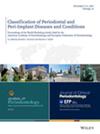Knowledge and use of digital technologies in periodontal practices in the United States: A survey study
Abstract
Background
The widespread adoption of digital technologies in dentistry has transformed workflows and practices. However, limited, if any, information is available on the extent of digital workflow integration in periodontics. This study aims to evaluate literacy, utilization, and knowledge of digital technologies, specifically implant navigation systems, among American board-certified periodontists.
Methods
This study utilized a survey with 16 multiple choice questions, sent through an online survey tool. Associations of survey responses with demographics, that is, experience (implant case load) and practice type, were statistically analyzed.
Results
A significant proportion of periodontists have incorporated digital technologies into their practices, with a majority utilizing cone beam computed tomography (CBCT) scanners and implant planning software. However, the adoption of more advanced technologies, such as dynamic or robotic navigation, remains limited. There was a significant difference in dynamic navigation utilization by participant experience and in robotic navigation utilization by practice type. Among the study participants, 40% reported the use of static navigation, with a notable percentage reporting its benefits in terms of increased accuracy and reduced morbidity for implant placement surgery. Despite a prevailing belief that digital tools are particularly valuable in complex cases, concerns about cost, complexity, and necessity were expressed regarding the adoption of these technologies.
Conclusion
There is widespread utilization of certain digital technologies, for example, three-dimensional radiography and static navigation, and very limited utilization of others, for example, robotic navigation, among US periodontists. Further research is needed to provide evidence of the benefits and efficacy of these technologies.
Plain Language Summary
A questionnaire was sent to implant and gum disease specialists in the United States, focused on evaluating the level of usage and understanding of different digital technologies in the field of implant placement in dentistry. Specialists were asked to answer questions related to their experience in the field, the kind of dental practice they were working at (corporate, private, or academic institution), and if they were using any of the available new dental technologies (including dental implant robots) in their practice. Results showed that most of the responding specialists were using 3D dental X-ray machines and software for planning the positions of dental implants on 3D X-rays, and around 40% of respondents were 3D-printing a resin template (guide) to facilitate accurate dental implant placement in the planned position. However, the usage of more advanced technologies, such as robotic arms, has not yet been widely adopted. It was clear that the kind of technology used was greatly affected by the kind of dental practice, and advanced technologies are used more in academic institutions than in any other kind of practice. Further research is needed to provide more evidence of the benefits of using the available digital technologies among specialists.




 求助内容:
求助内容: 应助结果提醒方式:
应助结果提醒方式:


